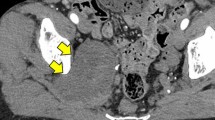Abstract
Background: Plexiform neurofibromas are a frequent complication of neurofibromatosis type 1. This article discusses MR imaging findings and distribution of plexiform neurofibromas in the abdomen and pelvis. Objective: To define the most prevalent patterns of involvement and MR imaging findings in abdominopelvic neurofibromatosis type 1. Materials and methods: We reviewed the MR appearance of abdominopelvic lesions in 23 male and 20 female patients (median age: 16 years) with type 1 neurofibromatosis. The patients were part of a multi-institutional study of 300 patients. Imaging included coronal or sagittal, and axial short tau inversion recovery images. Results: The most common abdominopelvic involvement was in the abdominopelvic wall (n=28, 65%) and lumbosacral plexus (n=27, 63%). Retroperitoneal involvement was frequent (n=15, 35%). Lesions were less often intraperitoneal (21%) (P=0.001). Pelvic disease (n=27, 63%), neural canal involvement (n=18, 42%), and hydronephrosis (n=4, 9%) were also noted. Target-like appearance of plexiform lesions was noted in more than half the patients. Conclusion: Abdominopelvic involvement in neurofibromatosis type 1 is primarily extraperitoneal. Although lesions are most prevalent in the abdominopelvic wall and lumbosacral plexus, retroperitoneal and pelvic involvement is common and usually affects important organs. MR imaging added information in the initial and follow-up clinical evaluation of these patients.






Similar content being viewed by others
References
Ducatman BS, Scheithauer BW, Piepgras DG, et al (1986) Malignant peripheral nerve sheath tumors: a clinicopathologic study of 120 cases. Cancer 57:2006–2021
Tonsgard JH, Kwak SM, Short MP, et al (1998) CT imaging in adults with neurofibromatosis-1: frequent asymptomatic plexiform lesions. Neurology 50:1755–1760
Niku SD, Mattrey RF, Kalota SJ, et al (1995) MRI of pelvic neurofibromatosis. Abdom Imaging 20:176–178
Ros PR, Eshaghi N (1991) Plexiform neurofibroma of the pelvis: CT and MRI findings. Magn Reson Imaging 9:463–465
Topsakal C, Erol FS, Ozercan I, et al (2001) Presacral solitary giant neurofibroma without neurofibromatosis Type 1 presenting as pelvic mass—case report. Neurol Med Chir (Tokyo) 41:620–625
Neurofibromatosis (1988) Conference statement. In: National institutes of health consensus development conference. Arch Neurol 45:575–578
Enzinger FM, Weis SM (1995) Benign tumors of peripheral nerves. In: Gray SM, Gery L (eds) Soft tissue tumors, 3rd edn. Mosby, St. Louis, pp 1130–1132
Huson SM, Harper PS, Compston DA (1988) Von Recklinghausen neurofibromatosis. A clinical and population study in south-east Wales. Brain 111(Pt6):1355–1381
Riccardi VM, Kleiner B (1977) Neurofibromatosis: a neoplastic birth defect with two age peaks of severe problems. Birth Defects Orig Arctic Ser 13:131–138
Sorensen SA, Mulvihill JJ, Nielsen A (1986) Long-term follow-up of von Recklinghausen neurofibromatosis. Survival and malignant neoplasms. N Engl J Med 314:1010–1015
Packer RJ, Gutmann DH, Rubenstein A, et al (2002) Plexiform neurofibromas in NF1: toward biologic-based therapy. Neurology 58:1461–1470
Imbert JP, Pilleul F, Valette PJ (2002) Value of MRI in hepatic plexiform neurofibromatosis. Case report. Gastroenterol Clin Biol 26:791–793
Bass JC, Korobkin M, Francis IR, et al (1994) Retroperitoneal plexiform neurofibromas: CT findings. AJR 163:617–620
Biondetti PR, Vigo M, Fiore D, et al (1983) CT appearance of generalized von Recklinghausen neurofibromatosis. J Comput Assist Tomogr 7:866–869
Korf BR (1999) Plexiform neurofibromas. Am J Med Genet (Semin Med Genet) 89:31–37
Lannicelli E, Rossi G, Almberger M, et al (2002) Integrated imaging in peripheral nerve lesions in Type 1 neurofibromatosis. Radiol Med 103:332–343
Acknowledgments
We thank Meera Gupta, project manager, Susan Yan of Worldcare Inc. for help in the co-ordination of sites, and Noemi Chavez for help with the manuscript preparation. Supported by U.S. Army Grant No. NF70002, “Natural History of Plexiform Neurofibromas in NF1”.
Author information
Authors and Affiliations
Corresponding author
Rights and permissions
About this article
Cite this article
Zacharia, T.T., Jaramillo, D., Poussaint, T.Y. et al. MR imaging of abdominopelvic involvement in neurofibromatosis type 1: a review of 43 patients. Pediatr Radiol 35, 317–322 (2005). https://doi.org/10.1007/s00247-004-1352-z
Received:
Revised:
Accepted:
Published:
Issue Date:
DOI: https://doi.org/10.1007/s00247-004-1352-z




